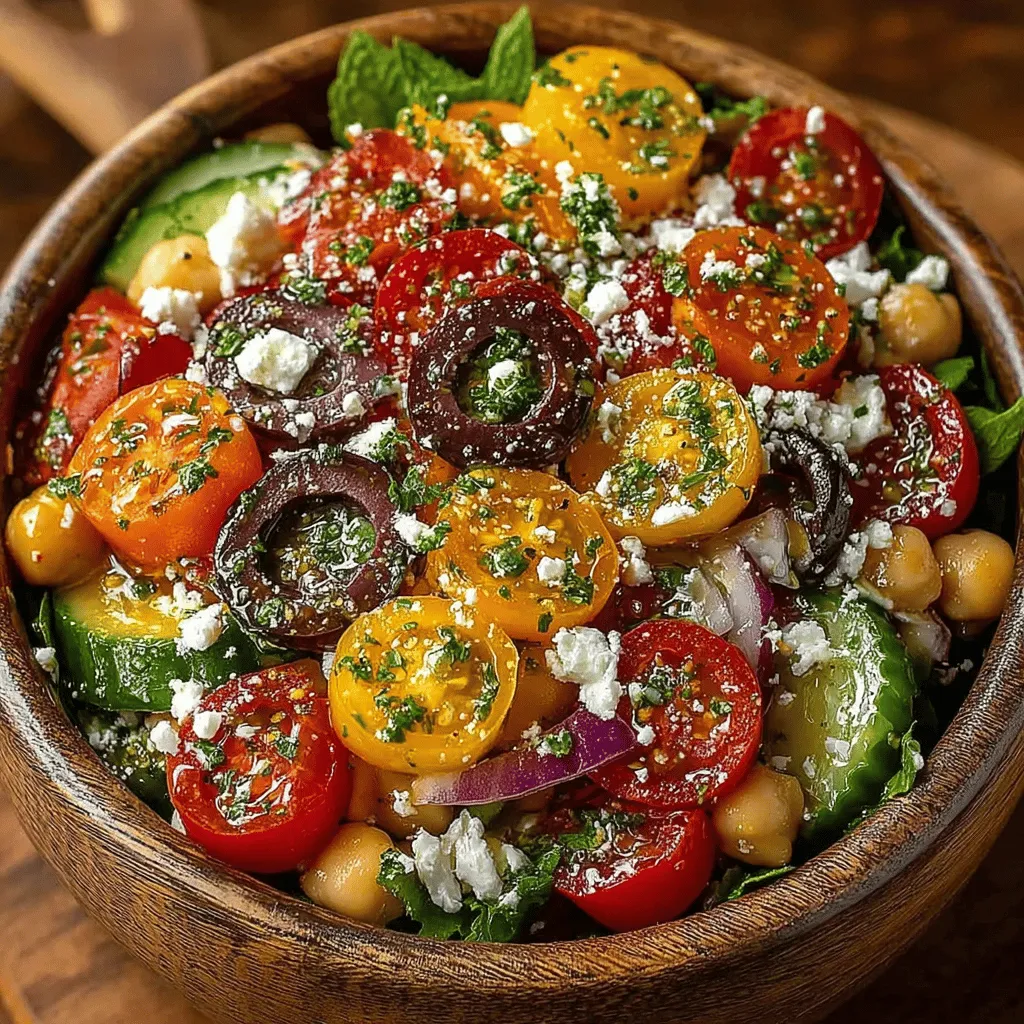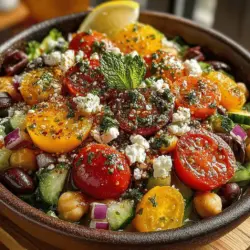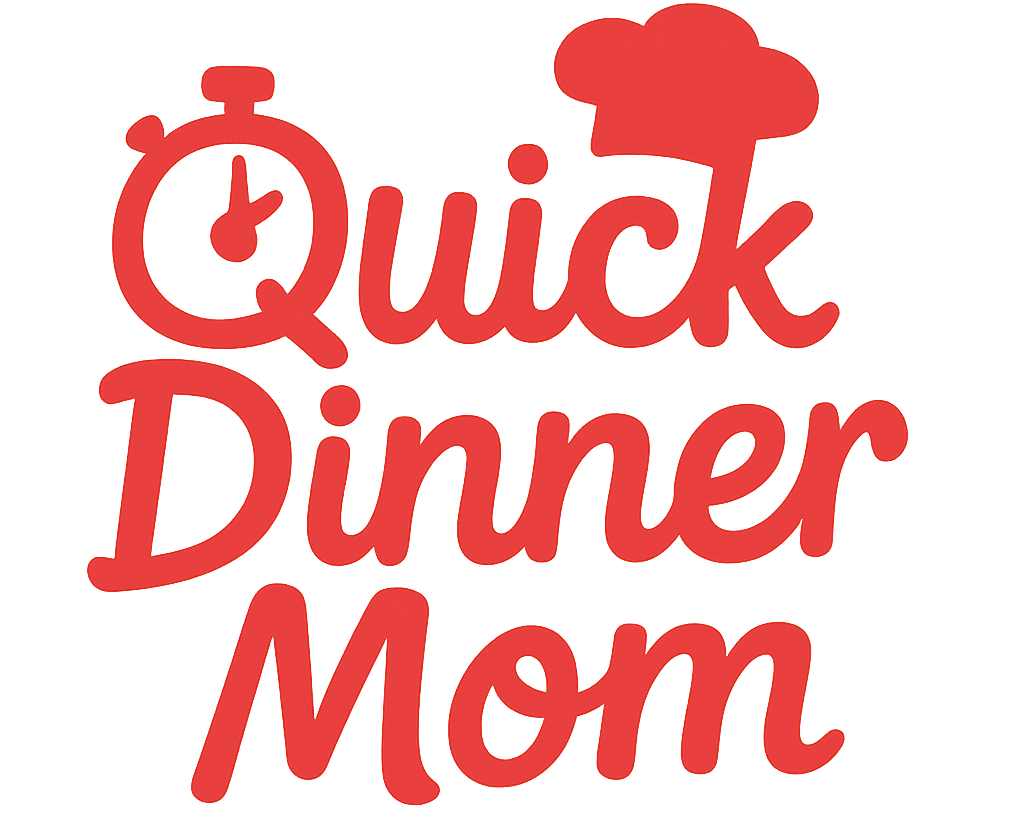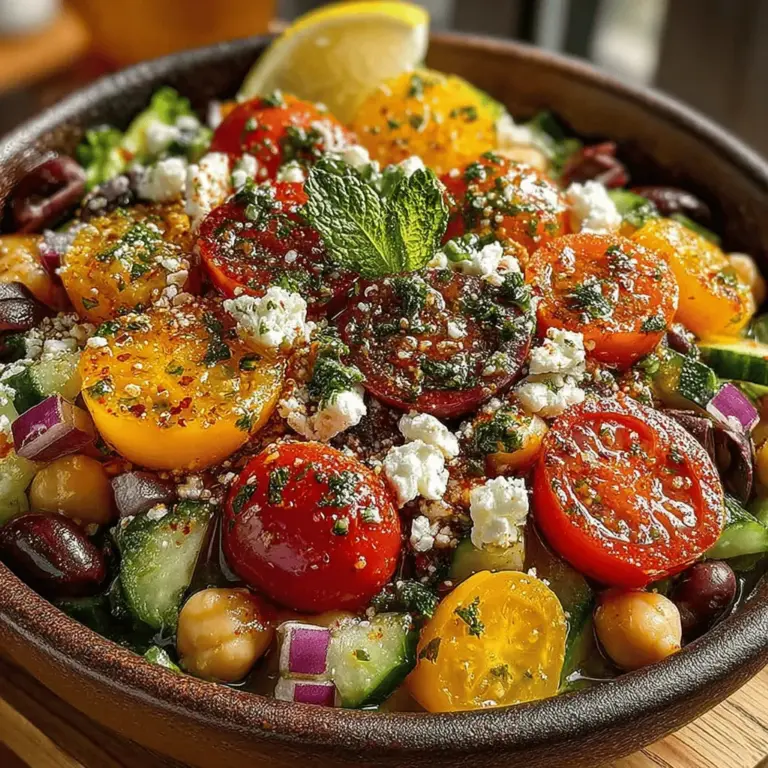Fresh & Vibrant Mediterranean Chickpea Salad Bowls
Introduction
Mediterranean cuisine is celebrated for its rich flavors, vibrant colors, and health benefits. Rooted in the dietary traditions of countries bordering the Mediterranean Sea, such as Greece, Italy, and Spain, this cuisine emphasizes whole foods, fresh vegetables, lean proteins, and healthy fats. A hallmark of the Mediterranean diet is its focus on ingredients that promote longevity and overall wellness, making it a favorite among health-conscious eaters.
One dish that embodies the essence of Mediterranean cooking is the Fresh & Vibrant Mediterranean Chickpea Salad Bowls. This recipe is a perfect blend of nutrition and flavor, making it an ideal choice for anyone looking to maintain a balanced diet without sacrificing taste. Packed with plant-based protein, fiber, and an array of vitamins from fresh vegetables, this salad is not only satisfying but also incredibly versatile. Whether you’re meal prepping for the week, hosting a gathering, or in need of a quick lunch option, these chickpea salad bowls deliver on all fronts.
What makes this recipe particularly appealing is its simplicity. With minimal cooking required and a straightforward assembly process, you can whip up a delicious and nutritious meal in no time. The combination of ingredients used in this salad not only brings a burst of flavor but also contributes to a well-rounded meal that aligns with health goals.
Understanding the Ingredients
To fully appreciate the Fresh & Vibrant Mediterranean Chickpea Salad Bowls, it’s essential to understand the key ingredients that make this dish both nourishing and flavorful.
Chickpeas
At the heart of this salad are chickpeas, also known as garbanzo beans. These legumes are a staple in Mediterranean cuisine and are celebrated for their impressive nutritional profile. Chickpeas are rich in plant-based protein, making them an excellent alternative to meat for those following vegetarian or vegan diets. They are also high in dietary fiber, which aids digestion and promotes a feeling of fullness, making them a perfect addition to any meal aimed at weight management.
In addition to protein and fiber, chickpeas are a good source of essential vitamins and minerals, including folate, iron, and magnesium. Their versatility allows them to blend seamlessly into various dishes, and they play a significant role in the Mediterranean diet, often featured in dishes like hummus and falafel. By incorporating chickpeas into your diet, you not only enjoy their delicious, nutty flavor but also reap the numerous health benefits they offer.
Fresh Vegetables and Herbs
Fresh vegetables are a cornerstone of the Mediterranean Chickpea Salad Bowls, and each ingredient contributes its unique flavor and texture. Key components include cherry tomatoes, cucumber, red onion, and bell peppers.
– Cherry Tomatoes: These bite-sized tomatoes add a burst of sweetness and acidity to the salad. They are rich in antioxidants, particularly lycopene, which has been linked to numerous health benefits, including reduced risk of chronic diseases.
– Cucumber: Known for its refreshing crunch, cucumber adds a hydrating element to the salad. Low in calories and high in water content, cucumbers are perfect for maintaining hydration while providing essential nutrients like vitamin K.
– Red Onion: With its sharp yet sweet flavor, red onion brings depth to the dish. It contains compounds that may help reduce inflammation and support heart health.
– Bell Peppers: Available in various colors, bell peppers are not only visually appealing but also a great source of vitamin C, which supports the immune system and skin health.
To elevate the flavor profile further, fresh herbs such as parsley and mint are essential. These herbs not only add vibrant colors but also contribute aromatic notes that brighten the overall dish. Parsley is known for its high levels of vitamins A, C, and K, while mint provides a refreshing twist that complements the other ingredients beautifully.
Feta Cheese and Kalamata Olives
No Mediterranean dish would be complete without the inclusion of feta cheese and Kalamata olives. Feta cheese, a crumbly and tangy cheese made from sheep or goat’s milk, adds a creamy texture and enhances the flavor complexity of the salad. It is lower in calories compared to many other cheeses and provides a good source of calcium and protein.
Kalamata olives, with their rich, briny flavor, offer a delightful contrast to the other ingredients. These olives are packed with healthy monounsaturated fats, which can support heart health. Their presence in the salad not only enhances the flavor but also aligns perfectly with the Mediterranean dietary principles of incorporating healthy fats.
Olive Oil and Lemon Juice
To tie all the ingredients together, a dressing made from extra-virgin olive oil and fresh lemon juice is essential. Extra-virgin olive oil is renowned for its health benefits, being rich in antioxidants and healthy fats that can help reduce inflammation and lower the risk of chronic diseases. It serves as a base for the dressing, imparting a smooth richness to the salad.
Fresh lemon juice is crucial for balancing flavors, adding a zesty brightness that lifts the dish. The acidity of lemon juice helps to enhance the natural flavors of the vegetables and other ingredients, making each bite refreshing and invigorating.
Step-by-Step Guide to Making Mediterranean Chickpea Salad Bowls
Creating your Fresh & Vibrant Mediterranean Chickpea Salad Bowls is a straightforward process that begins with the preparation of the ingredients.
Preparation of Ingredients
1. Rinse and Prepare Chickpeas: Start by rinsing canned chickpeas under cold water in a fine-mesh strainer. This step is crucial for removing excess sodium and any canning liquids. After rinsing, allow the chickpeas to drain well. If you prefer, you can use dried chickpeas; however, they will need to be soaked overnight and cooked until tender before use.
2. Chop the Vegetables: Next, prepare the fresh vegetables. For the cherry tomatoes, halve them for easy eating. When chopping the cucumber, aim for bite-sized pieces, removing the seeds if desired for a less watery texture. Finely dice the red onion to ensure its sharp flavor integrates well without overpowering the dish. For the bell peppers, remove the seeds and slice them into thin strips or small cubes, depending on your preference.
3. Fresh Herbs: For the parsley and mint, wash them thoroughly and dry them well. Chop them finely, which will release their aromatic oils and allow their flavors to permeate the salad.
Crafting the Dressing
The dressing is an essential component that can make or break your salad. In a small bowl, combine a generous amount of extra-virgin olive oil with freshly squeezed lemon juice. A common ratio is three parts olive oil to one part lemon juice, but feel free to adjust based on your taste preference. Add a pinch of salt and freshly cracked black pepper, and whisk until well blended. For those who like a bit more flavor, consider adding minced garlic or a hint of Dijon mustard to the dressing for added depth.
Combining Ingredients
Once all the components are prepared, it’s time to combine everything. In a large mixing bowl, add the rinsed chickpeas, chopped vegetables, fresh herbs, crumbled feta cheese, and Kalamata olives. Drizzle the dressing over the top and gently toss everything together until well combined. Be careful not to mash the chickpeas; you want to maintain their integrity for texture.
This Fresh & Vibrant Mediterranean Chickpea Salad can be served immediately, but letting it sit for a few minutes allows the flavors to meld beautifully. Whether enjoyed as a meal on its own or as a side dish to complement your favorite protein, this salad is sure to be a hit. Stay tuned for the next part of this article, where we will dive deeper into serving suggestions and variations to customize your Mediterranean salad experience.

Techniques for Ensuring Even Distribution of the Dressing
Achieving a well-dressed salad is crucial for maximizing flavors in your Mediterranean Chickpea Salad. To ensure even distribution of the dressing, follow these techniques:
1. Combine Ingredients Before Dressing: First, mix the salad ingredients in a large bowl. This allows you to see the ratios and ensure everything is well combined before adding the dressing.
2. Use a Jar for Dressing: Mixing the dressing in a mason jar is practical. Shake it vigorously until it emulsifies. This method allows for easier pouring and helps to coat every ingredient evenly.
3. Toss Gently but Thoroughly: Once the dressing is added, use two large spoons or salad tongs to toss the salad gently. This action helps to coat each component without bruising delicate greens or breaking apart the chickpeas.
4. Layering Technique: For presentation, consider layering the salad ingredients in the serving bowl. Start with greens at the bottom, followed by chickpeas, veggies, and finally the dressing on top. When serving, guests can mix their salads, ensuring everyone gets a balance of flavors.
Importance of Letting the Salad Sit to Meld Flavors
After mixing, let your salad sit for at least 15-30 minutes before serving. This resting period is essential for several reasons:
– Flavor Meld: The ingredients will have time to absorb the dressing, allowing the flavors to blend harmoniously.
– Texture Improvement: Allowing the salad to sit softens the vegetables slightly without losing their crunch, creating a more enjoyable eating experience.
– Enhanced Aroma: The resting time allows the herbs and spices to release their essential oils, intensifying the overall fragrance of the salad.
Serving Suggestions
When it comes to presenting your Mediterranean Chickpea Salad, creativity can elevate the dining experience. Here are some serving suggestions:
– Bowl Presentation: Use deep, wide bowls to showcase the colorful layers of the salad. This not only looks appealing but also encourages diners to mix their salads before eating.
– Mini Jars or Glasses: For a fun twist, serve individual portions in small jars or glasses. This approach is perfect for parties or picnics, allowing guests to enjoy a personal serving while showcasing the beautiful layers.
– Platter Style: For a larger gathering, consider serving the salad family-style on a large platter. Arrange the salad in the center with a small bowl of extra dressing on the side, inviting everyone to help themselves.
Creative Ways to Present the Salad in Bowls
Presentation matters, especially with a dish as vibrant as this Mediterranean Chickpea Salad. Here are some creative ideas:
– Color Contrast: Use contrasting colors in your bowls. For instance, pair a bright white bowl with colorful ingredients like red cherry tomatoes, green cucumbers, and deep black olives.
– Edible Bowls: Serve the salad in hollowed-out bell peppers or large lettuce leaves for a unique touch. This not only adds flavor but also reduces waste.
– Toppings Display: Arrange toppings like feta cheese, nuts, or seeds on top of the salad, creating an inviting visual appeal. This method allows guests to see what they can add.
Optional Garnishes and Their Impact on Presentation and Flavor
Enhance your salad with optional garnishes that not only elevate flavor but also improve presentation:
– Feta Cheese: Crumbled feta adds a salty richness that complements the salad beautifully. It also provides a visual contrast against the vibrant vegetables.
– Fresh Herbs: Sprinkle fresh herbs like parsley, mint, or dill on top for an extra burst of freshness and color.
– Toasted Nuts or Seeds: Adding toasted pine nuts, walnuts, or sunflower seeds introduces a satisfying crunch and nutty flavor.
– Olive Oil Drizzle: A final drizzle of high-quality extra virgin olive oil before serving can enhance the salad’s richness and give it a polished finish.
Nutritional Information
Understanding the nutritional benefits of the Mediterranean Chickpea Salad can help you appreciate its place in a balanced diet:
– Calories: Approximately 280 calories per serving.
– Protein: Chickpeas are a great source of plant-based protein, offering about 12 grams per serving.
– Fats: With healthy fats coming from olive oil and optional nuts, expect around 10 grams of fat, primarily unsaturated.
– Carbohydrates: This salad contains about 35 grams of carbohydrates, predominantly from chickpeas and vegetables.
Discussion on the Health Benefits of Each Ingredient
– Chickpeas: Packed with protein and fiber, chickpeas support digestion and help maintain stable blood sugar levels. They also provide essential vitamins and minerals such as iron and folate.
– Vegetables: Fresh vegetables like cucumbers, bell peppers, and tomatoes contribute vitamins A and C, potassium, and antioxidants, making this salad rich in nutrients.
– Olive Oil: Known for its heart-healthy monounsaturated fats, olive oil has anti-inflammatory properties and is associated with numerous health benefits, including improved heart health.
How This Salad Fits Into a Balanced Diet
The Mediterranean Chickpea Salad is not only delicious but also fits seamlessly into a balanced diet. It provides a mix of macronutrients—carbohydrates, proteins, and fats—along with essential vitamins and minerals. This salad can serve as a main dish or side, making it a versatile option for lunch or dinner. Its high fiber content also promotes satiety, helping you feel full longer.
Meal Prep and Storage Tips
To make your Mediterranean Chickpea Salad even more convenient, consider the following meal prep and storage tips:
Best Practices for Storing the Salad
– Separate Components: For optimal freshness, store the salad components separately. Keep the dressing in a jar, and the salad ingredients in an airtight container. This prevents sogginess and keeps the vegetables crisp.
– Use Glass Containers: Glass containers are excellent for storing salad ingredients as they do not retain odors and are easy to clean.
How to Keep Ingredients Fresh When Preparing in Advance
– Choose Fresh Ingredients: Select the freshest vegetables and herbs available. This not only enhances flavor but also prolongs the salad’s shelf life.
– Store in Cool Conditions: Keep your salad in the refrigerator at a consistent temperature to maintain freshness. Avoid leaving it out at room temperature for extended periods.
Recommendations for Variations to Keep the Dish Exciting Throughout the Week
– Change Up the Greens: Swap out romaine for arugula or spinach for different textures and flavors.
– Seasonal Vegetables: Utilize seasonal produce to keep your salad vibrant and fresh. For instance, add roasted butternut squash in the fall or asparagus in the spring.
– Protein Additions: Consider adding grilled chicken, shrimp, or boiled eggs for a heartier meal. This not only provides additional protein but also changes the flavor profile.
Variations and Customizations
Explore various adaptations of the Mediterranean Chickpea Salad to cater to different dietary needs or preferences.
Explore Alternatives for Different Dietary Needs
– Vegan: The basic recipe is already vegan-friendly! Just ensure that any optional toppings, such as feta cheese, are plant-based.
– Gluten-Free: This salad is naturally gluten-free, making it a great option for those with gluten sensitivities.
Suggestions for Adding Proteins or Grains for a Heartier Meal
– Quinoa or Farro: Incorporate grains like quinoa or farro for added texture and protein, making the dish more filling.
– Tofu or Tempeh: For a plant-based protein boost, add cubed, marinated tofu or tempeh, which can absorb the flavors of the salad beautifully.
Flavor Variations with Spices or Different Herbs
– Herb Swaps: Experiment with different herbs such as basil or cilantro for a unique twist.
– Spice It Up: Add a pinch of cumin or smoked paprika for a smoky flavor. A dash of red pepper flakes can also introduce a pleasant heat.
Cultural Significance of Chickpea Salad in Mediterranean Cuisine
Chickpeas have been a staple in Mediterranean diets for centuries, reflecting the cultural and historical significance of this nutritious legume.
Historical Context of Chickpeas in Mediterranean Diets
Chickpeas, also known as garbanzo beans, have been cultivated in the Mediterranean region since ancient times. They are rich in protein and were a vital food source for various civilizations, including the Romans and Greeks. Today, they continue to be a crucial ingredient in Mediterranean cooking, celebrated for their versatility and health benefits.
The Role of Salads in Mediterranean Culture and Lifestyle
Salads play an integral role in Mediterranean cuisine, often served as a refreshing starter or side dish. The Mediterranean diet emphasizes fresh, whole ingredients and promotes communal eating, reflecting the region’s emphasis on family and social gatherings. Salads are enjoyed year-round, celebrating seasonal produce and local ingredients.
How This Dish Reflects the Vibrant, Fresh Nature of Mediterranean Cooking
The Fresh & Vibrant Mediterranean Chickpea Salad embodies the essence of Mediterranean cooking, emphasizing fresh vegetables, wholesome grains, and healthy fats. Its colorful presentation and diverse flavors showcase the region’s culinary philosophy of using simple, high-quality ingredients to create dishes that are both nutritious and satisfying.
Conclusion
The Fresh & Vibrant Mediterranean Chickpea Salad Bowls are a delightful fusion of flavors, textures, and nutritional benefits. With its ease of preparation, this salad stands out as a versatile option suitable for any meal.
Whether you enjoy it as a light lunch, a side dish for dinner, or a refreshing snack, this recipe invites you to explore the rich traditions of Mediterranean cuisine. The health benefits of its ingredients make it a nutritious choice that fits seamlessly into a balanced diet.
Encourage yourself to experiment with variations and enjoy the vibrant flavors of the Mediterranean. This salad is not just a meal; it’s an opportunity to embrace a healthier lifestyle while savoring the essence of fresh, wholesome ingredients. Dive into the refreshing world of Mediterranean cooking with this simple yet delicious recipe!


